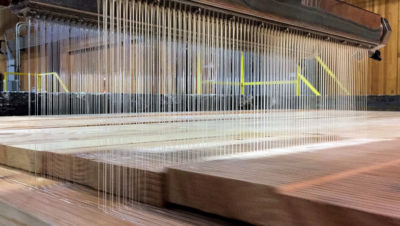As mass timber takes off, how green is this new building material?
Climate-positive mass timber construction is on the rise — but will producing the new material outweigh its benefits?

Mjösa Tower, the world's tallest wooden building, under construction in Brumunddal, Norway.
This story was originally published on Yale e360.
The eight-story Carbon 12 building in Portland, Oregon is the tallest commercial structure in the United States to be built from something called mass timber.
If the many fervent boosters of this new construction material are right, however, it is only one of the first mass timber buildings among many, the beginning of a construction revolution. "The design community in Portland is enthralled with the material," said Emily Dawson, an architect at Kaiser + Path, the locally-based firm that designed Carbon 12.
The move to mass timber is even farther along in Europe. That’s because mass timber — large structural panels, posts and beams glued under pressure or nailed together in layers, with the wood’s grain stacked perpendicular for extra strength — is not only prized as an innovative building material, superior to concrete and steel in many ways, it is also hoped it will come into its own as a significant part of a climate change solution.
Among architects, manufacturers and environmentalists, many want nothing less than to turn the coming decades (PDF) of global commercial construction from a giant source of carbon emissions into a giant carbon sink (PDF) by replacing concrete and steel construction with mass timber. That, they say, would avoid the CO2 generated in the production of those building materials and sequester massive amounts of carbon by tying up the wood in buildings for decades or even longer, perhaps in perpetuity.

And it is taking off. Mass timber has a two-decade track record in Europe. The 18-story Mjösa Tower just opened last month in Norway. An 18-story mass timber building recently was built in Vancouver as well, and an 80-story high-rise is proposed for Chicago. There are new commercial mass timber buildings in London, Atlanta and Minneapolis. Some 21 timber buildings over 164 feet tall will be completed in Europe by the end of the year, according to one report (PDF).
But big questions are being asked about just how sustainable the new building material is — especially about how forests that produce mass timber are managed, and how much CO2 would be emitted in the logging, manufacture and transport of the wood products used in the construction. So far, critics say, there aren’t good answers to these questions.
"We want to debunk the myth that mass timber is in any way, shape, or form related to some kind of environmental benefit," said John Talberth, president of the Center for Sustainable Economy, based near Portland. "That’s simply not true."
Yet proponents say mass timber does have real promise as a way to sequester massive amounts of CO2, if a fully sustainable life cycle comes together. "We are working with a large interdisciplinary team of climate scientists, carbon cycle researchers, metallurgists and foresters to really understand the potential climate impacts of mass timber at scale," said Ruff.
A lack of understanding of the full CO2 picture has not kept the field from taking off. The burgeoning demand for mass timber posts and beams has seen sawmills open in the timber towns of the U.S. Northwest and loggers go back to work to harvest the pine, fir and spruce used in the manufacture. The first certified U.S. producer of mass timber — also known as cross-laminated timber — opened in Riddle, Oregon in 2015. Other producers either recently have opened or soon will. Analysts call it a revolution in building and the next great disruption of the construction industry, for a number of reasons that have nothing to do with the environmental aspects.
"Because its components are fabricated off-site to [precise specifications], it goes together really fast on site," said Dawson. “So you can cut months off the construction time. It’s more predictable than concrete. You can work through cold weather and don’t have to worry about the temperature tolerances of concrete. It’s also a lot quieter than other kinds of construction, so you can be a good neighbor." It’s stronger than steel, lighter and, surprisingly, may be as fireproof.
Architects say the exposed wood interiors in these buildings are warmer than other materials and far more aesthetically pleasing. Michael Green, who builds mass timber structures in British Columbia, said some people walk into buildings he has designed and want to hug the wooden interiors. The dense laminated beams also hold up well to fire, unlike other kinds of wood construction.
Mass timber can be cheaper than concrete and steel, depending on where it is sourced. And when production is scaled up across the globe, experts say, mass timber should be considerably cheaper.
The possible prodigious climate benefits, though, are what has many people taking mass timber seriously. These benefits come because of two big facts about commercial construction. First, CO2 emissions from the building industry account for about 40 percent or more of global CO2 emissions. And the manufacture of concrete and steel each contribute about 5 percent of global emissions.CO2 emissions from the building industry account for about 40 percent of global CO2 emissions. And the manufacture of concrete and steel contribute about 5 percent.
Using mass timber for commercial construction could greatly change that equation. But there are key questions about the life cycle of mass timber, and some say the industry doesn’t have enough data yet to back up its claim that it is a major climate change solution.

After the building has run its course, the beams would need to be stored without decomposing or re-used without releasing the CO2 in order to make the carbon equation work. And there are numerous unknowns about how much CO2 would be expelled in the logging, manufacturing and transport of mass timber products. The forest products industry is already the largest source of CO2 emissions in Oregon because of fuel burned by logging equipment and hauling trucks, the burning of wood and the decomposition of trees after they are cut.
Beverly Law, a professor of global change biology and terrestrial systems science at Oregon State University who headed up the Oregon forest study, says there hasn’t been a thorough analysis of carbon emitted by mass timber production because it is enormously complex to track the factors that produce CO2 in forest ecosystems and in production. Some data needed, she said, is incomplete or absent. It took her team of researchers more than a decade of analysis to figure out that the Oregon wood products industry was the largest emitter of CO2 in the state, Law said.
"We looked at long- and short-term products, what mills burn for heat, fuel burned for harvesting, transporting from forest to mills to end use, and emissions along the way," she said. Another major issue is how long the wood will be in use, which is not yet known. In addition, Law said, any analysis of CO2 must account for how much the forest is taking up before and after logging, "and a lot of people don’t pay attention to that part of it. We just don’t have the information to run this through a life cycle assessment."
The forestry part is what has some skeptical of how ecologically sound mass timber is and, if and when it’s scaled up, whether it will truly provide a planetary climate solution. In a letter (PDF) to the city of Portland last year, representatives of Oregon environmental groups — including the Audubon Society, the Sierra Club and Oregon Physicians for Social Responsibility — raised serious doubts about mass timber as a green climate solution and questioned the city’s plan to use it.The forestry part is what has some skeptical of how ecologically sound mass timber is and, if and when it’s scaled up, whether it will truly provide a planetary climate solution.
First and foremost, they said, is the need to certify that wood is logged sustainably and certified as such. "Without such a requirement," the letter stated, the city "may be encouraging the already rampant clear-cutting of Oregon’s forests… In fact, because it can utilize smaller material than traditional timber construction, it may provide a perverse incentive to shorten logging rotations and more aggressively clear-cut."

"We must ensure that mass timber drives sustainable forestry management, otherwise all of these benefits are lost," agreed Mark Wishnie, director of forestry and wood products at The Nature Conservancy. "To really understand the potential impact of the increased use of mass timber on climate we need to conduct a much more detailed set of analyses."
Wishnie said The Nature Conservancy, the U.S. Forest Service and a dozen universities and other research institutions are launching a new analysis of mass timber.
At the same time, he said, "there is enough data to say the [CO2] savings are significant." He said the substitution of concrete and steel with wood and the long-term carbon storage in mass timber buildings make up about 75 percent of the total benefit, and the forestry end, if executed sustainably, about 25 percent.
While there is disagreement on many points, making the mass timber movement work, proponents say, is essential. "If you look 30 years down the road to 2050, we’re projected to have 2.3 billion new urban dwellers," said Ruff. "That is a huge amount of construction. Every day that goes by that we don’t convert from mineral-based extractive construction techniques to carbon sequestering building systems, we tend to dig ourselves further in a hole.
"So, the question is, how can we grow this fast enough to be a solution for climate change?"





